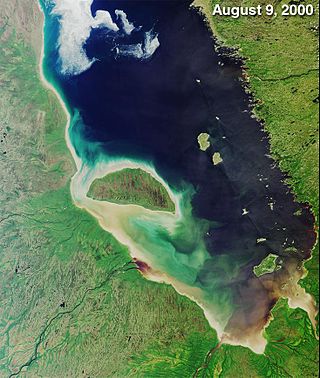
James Bay is a large body of water located on the southern end of Hudson Bay in Canada. Both bodies of water extend from the Arctic Ocean, of which James Bay is the southernmost part. Despite bordering the Canadian provinces of Quebec and Ontario, the bay and the islands within it, the largest of which is Akimiski Island, are politically part of Nunavut.
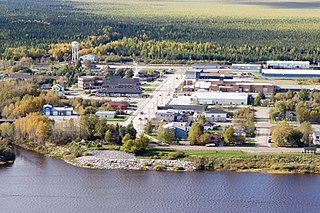
Moosonee is a town in northern Ontario, Canada, on the Moose River approximately 19 km (12 mi) south of James Bay. It is considered to be "the Gateway to the Arctic" and has Ontario's only saltwater port. Nearby on Moose Factory Island is the community of Moose Factory to which it is connected by water taxi in the summer and ice road in the winter.
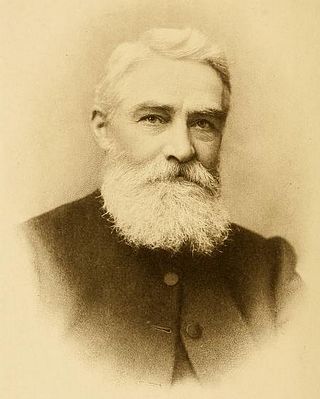
Edmund James Peck, known in Inuktitut as Uqammaq, was an Anglican missionary in the Canadian North on the Quebec coast of Hudson Bay and on Baffin Island. He founded the first permanent mission on Baffin Island, Nunavut. He developed Inuktitut syllabics, derived from the Cree syllabary and the first substantial English-Inuktitut dictionary.
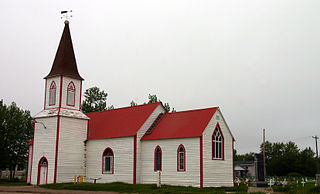
Moose Factory is a community in the Cochrane District, Ontario, Canada. It is located on Moose Factory Island, near the mouth of the Moose River, which is at the southern end of James Bay. It was the first English-speaking settlement in lands now making up Ontario and the second Hudson's Bay Company post to be set up in North America after Fort Rupert. On the mainland, across the Moose River, is the nearby community of Moosonee, which is accessible by water taxi in the summer, ice road in the winter, and chartered helicopter in the off-season.

Fort Albany First Nation is a Cree First Nation in Cochrane District in Northeastern Ontario, Canada, within the territory covered by Treaty 9. Situated on the southern shore of the Albany River, Fort Albany First Nation is accessible only by air, water, or by winter road.

The Diocese of Qu'Appelle in the Anglican Church of Canada lies in the southern third of the civil province of Saskatchewan and contains within its geographical boundaries some 50 per cent of the province's population of one million.

The Episcopal Diocese of New York is a diocese of the Episcopal Church in the United States of America, encompassing three New York City boroughs and seven New York state counties. Established in 1785, it is one of the Episcopal Church's original dioceses. The current diocesan bishop is the Rt. Rev. Andrew Dietsche, whose seat is at the Cathedral of Saint John the Divine; the Rt. Rev. Matthew Heyd was consecrated as bishop coadjutor in 2023 and will succeed Dietsche as diocesan bishop in 2024.
The Roman Catholic Archdiocese of Keewatin–Le Pas is a Roman Catholic archdiocese that includes parts of the Provinces of Manitoba, Saskatchewan, and Ontario and has the suffragan diocese of Churchill-Baie d'Hudson. The current archbishop is Murray Chatlain.

John Horden was the first Anglican Bishop of Moosonee, Canada, who for more than forty years led services in Cree, Inuit and other languages of his parishioners.

Colin Robert Johnson is the former Anglican archbishop of Toronto and Moosonee, and he served as Metropolitan of the Ecclesiastical Province of Ontario from 2009 to 2018. He was the 11th Bishop of Toronto, the largest diocese in the Anglican Church of Canada.
The Diocese of Algoma is a diocese of the Ecclesiastical Province of Ontario of the Anglican Church of Canada. It comprises nearly 182,000 square kilometres of the Ontario districts of Algoma, Thunder Bay, Sudbury, Manitoulin, and parts of the districts of Nipissing and Timiskaming. The diocese forms a wide band stretching from just west of Thunder Bay on the northern shore of Lake Superior east to the border of Ontario and Quebec. Neighbouring Anglican dioceses are Rupert's Land to the west, Moosonee to the north, Ottawa to the east, and Ontario, Toronto, Huron to the south.
The Diocese of Moosonee is a diocese of the Ecclesiastical Province of Ontario of the Anglican Church of Canada. It was created in 1872 from part of the Diocese of Rupert's Land, in what is now the Province of Rupert's Land, and transferred in 1912 to the new Province of Ontario. Now headquartered in Timmins, Ontario, it was originally headquartered in Moose Factory. Its first bishop was John Horden.
Moose Cree is a dialect of the Cree language spoken mainly in Moose Factory, Ontario.
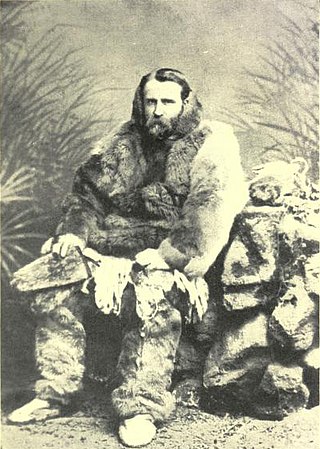
Joseph Lofthouse, Sr., was a Canadian Anglican bishop in the early 20th century.

Moose Factory Island is an island in the Moose River, Ontario, Canada, about 16 kilometres (10 mi) from its mouth at James Bay. It is adjacent to the community of Moosonee across the Moose River, from which it is accessible by water taxi. The island is home to the community of Moose Factory. This town is associated with the entire island, but politically, the island is divided into two entities:
Bible translations into Cree can be subdivided by dialect of the Cree language. The main dialects are Plains Cree language, Woods Cree language, Swampy Cree language, Moose Cree language, Northern East Cree language, Southern East Cree language, Kawawachikamach, Atikamekw language and the Montagnais language.
James Settee, was of Swampy Cree descent. He was given the name James Settee when he was baptized in 1827. He was the second Native American ordained an Anglican priest; following Henry Budd. He married Sarah (Sally) Cook in 1835. He was ordained an Anglican priest and spent his career ministering to First Nations people of Canada. He was fluent in English, Cree and Ojibwe.

The St. John's Indian Residential School, also known as the Chapleau Indian Residential School, was a Canadian Indian Residential School operated by the Anglican Church of Canada from 1907 to 1948 in Chapleau, Ontario.
Anne Germond is a South African-born Anglican bishop in Canada. Since 10 October 2018, she has served as Metropolitan of the Ecclesiastical Province of Ontario, as well as Archbishop of Algoma and Archbishop of Moosonee, in the Anglican Church of Canada. She had served as Bishop of Algoma from February 2017 until becoming its archbishop upon election as 19th Metropolitan of Ontario.

Bishop Horden Hall, also known as Bishop Horden Memorial School, Moose Factory Residential School, and Horden Hall, was a residential school that operated from 1906 until 1976 on Moose Factory Island, at the southern end of James Bay, at the bottom of Hudson Bay, in northern Ontario.














